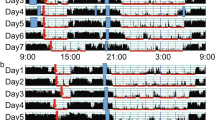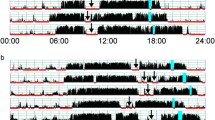Abstract
The purpose of this study was to describe the daytime activity levels and their association with sleep, fatigue, depressive symptoms, and quality of life. Wrist actigraphy and questionnaires were used to examine 51 mothers with a preterm infant during their second week postpartum. Circadian activity rhythms (CAR) were less synchronized in these mothers; they experienced sleep disturbances, fatigue, depressive symptoms, and poor health-related quality of life (H-QOL). Compared to high-activity mothers, mothers with low activity levels slept less during nighttime but napped more during daytime, and reported more postpartum depressive symptoms. Further research is needed to examine the effect of low activity level and sleep loss on postpartum depression, and to develop interventions for improving rest/activity patterns for new mothers.
Similar content being viewed by others
References
Ancoli-Israel S, Clopton P, Klauber MR, Fell R, Mason W (1997) Use of wrist activity for monitoring sleep/wake in demented nursing-home patients. Sleep 20:24–27
Ancoli-Israel S, Cole R, Alessi C, Chambers M, Moorcroft W, Pollak CP (2003) The role of actigraphy in the study of sleep and circadian rhythms. Sleep 26:342–392
Armstrong K, Edwards H (2003) The effects of exercise and social support on mothers reporting depressive symptoms: a pilot randomized controlled trial. Int J Ment Health Nurs 12:130–138
Borbely AA (1982) A two process model of sleep regulation. Hum Neurobiol 1(3):195–204
Borbely AA, Achermann P (1992) Concepts and models of sleep regulation: an overview. J Sleep Res 1:63–79
Brown AC, Smolensky MH, D’Alonzo GE, Redman DP (1990) Actigraphy: a means of assessing circadian patterns in human activity. Chronobiol Int 7:125–133
CDC (2010) Preterm birth. Retrived May 10, 2011, from www.cdc.gov/reproductivehealth?MaternalInfantHealth/PretermBirth.htm
Cox JL, Holden JM, Sagovsky R (1987) Detection of postnatal depression. Development of the 10-item Edinburgh Postnatal Depression Scale. Br J Psychiatry 150:782–786
Da Costa D, Lowensteyn I, Abrahamowicz M, Ionescu-Ittu R, Dritsa M, Rippen N, Cervantes P, Khalife S (2009) A randomized clinical trial of exercise to alleviate postpartum depressed mood. J Psychosom Obstet Gynaecol 30:191–200
Daley AJ, MacArthur C, Winter H (2007) The role of exercise in treating postpartum depression: a review of the literature. J Midwifery Womens Health 52:56–62
Ehlers CL, Frank E, Kupfer DJ (1988) Social zeitgebers and biological rhythms. A unified approach to understanding the etiology of depression. Arch Gen Psychiatry 45:948–952
Fletcher BS, Paul SM, Dodd MJ, Schumacher K, West C, Cooper B et al (2008) Prevalence, severity, and impact of symptoms on female family caregivers of patients at the initiation of radiation therapy for prostate cancer. J Clin Oncol 26:599–605
Gay CL, Lee KA, Lee SY (2004) Sleep patterns and fatigue in new mothers and fathers. Biol Res Nurs 5(4):311–318
Gehrman P, Marler M, Martin JL, Shochat T, Corey-Bloom J, Ancoli-Israel S (2005) The relationship between dementia severity and rest/activity circadian rhythms. Neuropsychiatr Dis Treat 1:155–163
Germain A, Kupfer DJ (2008) Circadian rhythm disturbances in depression. Hum Psychopharmacol 23(7):571–585
Goyal D, Gay C, Lee K (2009) Fragmented maternal sleep is more strongly correlated with depressive symptoms than infant temperament at three months postpartum. Arch Womens Ment Health 12:229–237
Greer TL, Trivedi MH (2009) Exercise in the treatment of depression. Curr Psychiatry Rep 11:466–472
Lee KA (1992) Self-reported sleep disturbances in employed women. Sleep 15:493–498
Lee KA (2003) Impaired sleep. In: Carrieri-Kohlman VA, Lindsey M, West CM (eds) Pathophysiological phenomena in nursing, 3rd edn. Saunders, St. Louis, pp 363–385
Lee SY (2007) Validating the general sleep disturbance scale among chinese american parents with hospitalized infants. J Transcult Nurs 18:111–117
Lee SY, Kimble LP (2009) Impaired sleep and well-being in mothers with low-birth-weight infants. J Obstet Gynecol Neonatal Nurs 38:676–685
Lee SY, Lee KA (2007) Early postpartum sleep and fatigue for mothers after cesarean delivery compared with vaginal delivery: an exploratory study. J Perinat Neonatal Nurs 21:109–113
Lee KA, Hicks G, Nino-Murcia G (1991) Validity and reliability of a scale to assess fatigue. Psychiatry Res 36:291–298
Lee KA, Portillo C, Miramontes H (1996) SLEEP B.E.T.R.E.R. University of California, San Francisco
Lee KA, Beyene Y, Paparrigopoulos TJ, Dikeos DG, Soldatos CR (2007a) Circadian rhythms and sleep patterns in urban Greek couples. Biol Res Nurs 9(1):42–48
Lee SY, Lee KA, Rankin SH, Weiss SJ, Alkon A (2007b) Sleep disturbance, fatigue, and stress among Chinese-American parents with ICU hospitalized infants. Issues Ment Health Nurs 28:593–605
Lee ML, Swanson BE, de la Iglesia HO (2009) Circadian timing of REM sleep is coupled to an oscillator within the dorsomedial suprachiasmatic nucleus. Curr Biol 19:848–852
Lee SY, Lee KA, Aycock D, Decker M (2010) Circadian activity rhythms for mothers with an infant in ICU. Front Neurol 1:155
Mayberry LJ, Horowitz JA, Declercq E (2007) Depression symptom prevalence and demographic risk factors among U.S. women during the first 2 years postpartum. J Obstet Gynecol Neonatal Nurs 36:542–549
McHorney CA, Ware JE Jr, Lu JF, Sherbourne CD (1994) The MOS 36-item Short-Form Health Survey (SF-36): III. Tests of data quality, scaling assumptions, and reliability across diverse patient groups. Med Care 32:40–66
Monteleone P, Martiadis V, Maj M (2010) Circadian rhythms and treatment implications in depression. Prog Neuropsychopharmacol Biol Psychiatry 35:1569–1574
Montgomery-Downs HE, Insana SP, Clegg-Kraynok MM, Mancini LM (2010). Normative longitudinal maternal sleep: the first 4 postpartum months. Am J Obstet Gynecol 203: 465.e1–7
NSF (2010) 2010 sleep and ethnicity. Retrived from http://www.sleepfoundation.org/article/sleep-america-poos/2010-sleep-and-ethnicity
Okun ML, Kiewra K, Luther JF, Wisniewski SR, Wisner KL (2011) Sleep disturbances in depressed and nondepressed pregnant women. Depress Anxiety 28:676–685
Posmontier B (2008) Sleep quality in women with and without postpartum depression. J Obstet Gynecol Neonatal Nurs 37:722–735
Postolache TT, Oren DA (2005) Circadian phase shifting, alerting, and antidepressant effects of bright light treatment. Clin Sports Med 24:381–413
Vigod SN, Villegas L, Dennis CL, Ross LE (2010) Prevalence and risk factors for postpartum depression among women with preterm and low-birth-weight infants: a systematic review. BLOG 117:540–550
Ware JE Jr, Sherbourne CD (1992) The MOS 36-item short-form health survey (SF-36). I. Conceptual framework and item selection. Med Care 30:473–483
Watson PE, McDonald BW (2007) Activity levels in pregnant New Zealand women: relationship with socioeconomic factors, well-being, anthropometric measures, and birth outcome. Appl Physiol Nutr Metab 32:733–742
Winkler D, Pjrek E, Praschak-Rieder N, Willeit M, Pezawas L, Konstantinidis A et al (2005) Actigraphy in patients with seasonal affective disorder and healthy control subjects treated with light therapy. Biol Psychiatry 58:331–336
Author information
Authors and Affiliations
Corresponding author
Rights and permissions
About this article
Cite this article
Lee, SY., Grantham, C.H., Shelton, S. et al. Does activity matter: an exploratory study among mothers with preterm infants?. Arch Womens Ment Health 15, 185–192 (2012). https://doi.org/10.1007/s00737-012-0275-1
Received:
Accepted:
Published:
Issue Date:
DOI: https://doi.org/10.1007/s00737-012-0275-1




